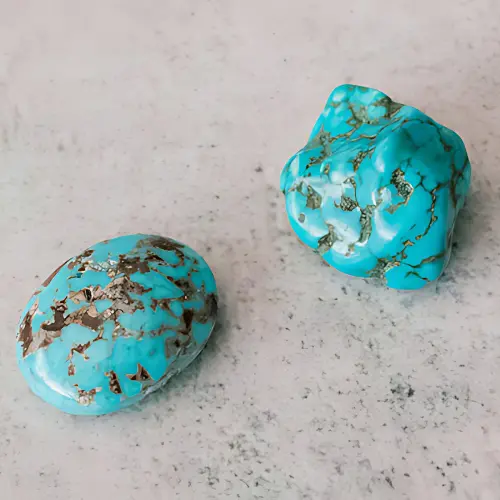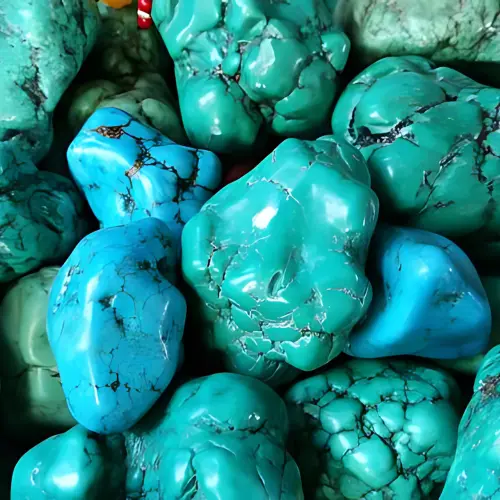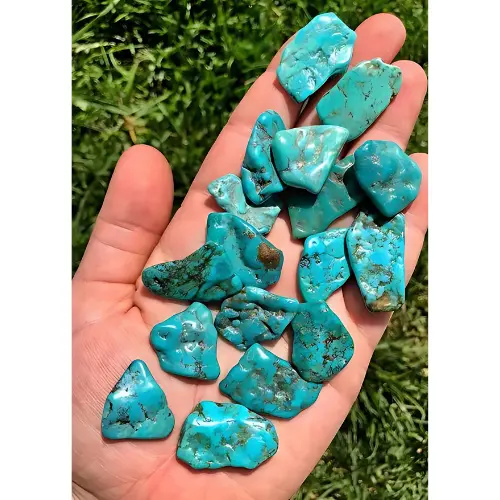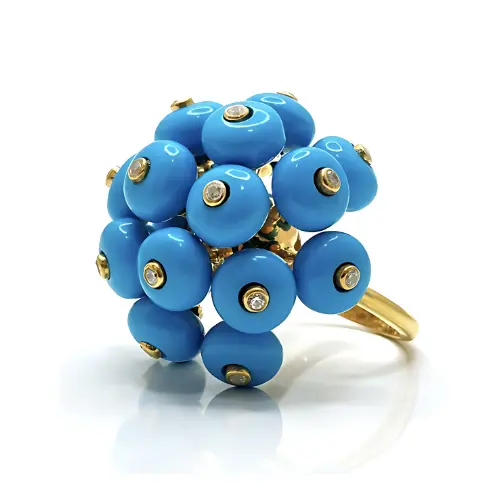
Turquoise, with its mesmerizing blue-green hue and mystical allure, has woven a rich tapestry of history, culture, and art throughout the ages. Originating thousands of years ago, this semi-precious gemstone has transcended borders, influencing mythology, superstition, and creativity across diverse civilizations.
Origins and Antiquity:

In the cradle of ancient civilizations, Egypt stood as one of the earliest appreciators of turquoise. Dating back to around 3000 BC, turquoise found its place in Pharaonic jewelry and in the tombs of kings, believed to offer spiritual protection and benefits. The gemstone's journey continued to ancient Persia, where it symbolized victory and good luck, earning the name "pirouzeh" meaning "victory." Persian warriors adorned themselves and their belongings with turquoise, hoping for divine protection.
Pre-Columbian Native American tribes, including the Hopi and Navajo, embraced turquoise as a symbol of wealth, happiness, and good luck. For the Navajo, wearing turquoise was a way to invoke favor from the gods.
Spread Across Eurasia and Beyond:

As trade routes connected the East and West, turquoise embarked on a journey along the Silk Road, reaching Europe by the 13th century. Adopting the name "turquoise" from the French term "_pierre tourques_" meaning "Turkish stone," it gained favor among Russian royalty and the Italian Medici family. The gemstone's perceived magical qualities, including bestowing good fortune and protection, resonated across the European continent.
In Asia, turquoise became integral to Buddhist rituals, incorporated into rosaries and religious ceremonies. Tibetans believed in its healing properties, leading to its inclusion in prayer boxes. The gemstone's diverse roles reflected its adaptability across cultures.
Modern Times and Continued Significance:

In the contemporary era, turquoise maintains its allure, particularly in the American Southwest, where artists and designers draw inspiration from its rich heritage. Despite challenges in sourcing natural turquoise, modern technology has facilitated the production of synthetic alternatives to meet demand.
Turquoise's global appeal, however, remains niche, with its charm predominantly captivating those enamored by the romanticism of the American West and its cultural legacy. Nevertheless, the gemstone persists as a symbol of hope, cherished across cultures for its decorative and protective qualities.
Turquoise as a Stone of Hope:
Embodying the cheeriness of the sunny sky, turquoise has been revered as a symbol of hope. Whether used as a decorative amulet, a protective charm for horses, or a rain bringer, the blue stone has consistently represented optimism throughout history.
Turquoise in Jewelry Industry:
Turquoise's popularity extends into the realm of jewelry, where it has become a cherished gemstone worldwide. Ranging in color from blue to blue-green and greenish-gray, the gemstone's hue is influenced by varying levels of copper. In today's jewelry market, turquoise and sterling silver form an iconic combination, especially prevalent in southwestern jewelry.
Genuine turquoise's popularity has led to its high price, prompting the use of simulated turquoise for those seeking its beautiful colors without the hefty cost. Online retailers like Almost Diamonds offer simulated turquoise jewelry, providing accessible options for enthusiasts. Designs featuring simulated turquoise briolette drops in sterling silver showcase the versatility and affordability of this enduring gemstone.
A unique characteristic of turquoise, both genuine and simulated, is its opacity. Unlike transparent gemstones, turquoise's appeal lies primarily in its vibrant colors. The sky blue version, often referred to as robin's egg, remains the most sought-after shade for jewelry design.
Legacy and Future Prospects:
While turquoise may not reach the pinnacle of prestige enjoyed by diamonds or rubies, its enduring legacy ensures its place in the hearts of collectors and enthusiasts. The gemstone's intricate relationship with culture, history, and folklore guarantees its continued fascination.
As we look to the future, turquoise's journey is far from over. Its timeless appeal and ability to adapt to changing times make it a gemstone that will continue to captivate and inspire generations to come. From ancient civilizations to modern jewelry enthusiasts, turquoise stands as a testament to the enduring power of beauty and symbolism in the world of gemstones.
You may also like:
BURMESE RUBY - HISTORY OF RED
THE PATRICIA EMERALD: A GEM OF LEGENDS AND LUXURY
KASHMIR SAPPHIRE: UNVEILING THE MYSTIQUE OF THE HIMALAYAN GEM










